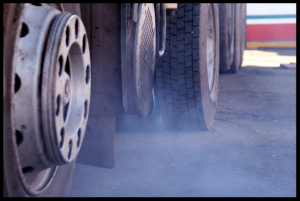[vc_row][vc_column][vc_column_text]
| Clear the Air | Dangers of Diesel Exhaust |
[/vc_column_text][/vc_column][/vc_row][vc_row][vc_column width=”2/3″ css=”.vc_custom_1561886618985{margin-top: -5px !important;}”][vc_column_text css=”.vc_custom_1566429972866{margin-top: -20px !important;}”]If you work near or around diesel engines, you need to be aware of the hazards of diesel exhaust exposure. The negative health effects of exposure to diesel exhaust include a wide range of problems, including irritations of the eyes and nose, headaches, respiratory disease, cardiovascular disease, and lung cancer.
Diesel engines are standard in a variety of work equipment such as trucks, bulldozers, tractors, trains, ships, mine equipment, buses, generators and bucket lifts.[/vc_column_text][/vc_column][vc_column width=”1/3″][vc_column_text css=”.vc_custom_1569260390194{margin-bottom: 60px !important;}”]
So what can you do about diesel exhaust in your workplace? First, ensure your employer is aware of your concern. Where needed, employers should assess the risks of diesel exhaust and take the necessary precautions to ensure a safe and healthy workplace. Engineering and administrative controls can be implemented in the workplace to help minimize worker exposure to diesel exhaust. Some examples of controls include:
- Minimize emissions by performing routine maintenance on diesel engines.
- Install engine exhaust filters and/or cleaner burning engines.
- Filter the air in equipment cabs or other high diesel exhaust areas.
- For indoor locations, install ventilation systems to capture and remove emissions.
- Ensure the ventilation system can handle the amount of exhaust produced in the work area.
- Limit speeds, traffic congestion and engine idling in work areas.
- Restrict the number of diesel engines and total engine horsepower allowed in the work area.
Through proper implementation of controls, diesel exhaust risks to workers can be minimized. For more information on this topic, visit OSHA’s Diesel Exhaust page.[/vc_column_text][/vc_column][/vc_row]





